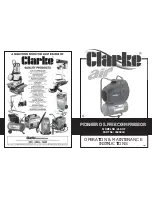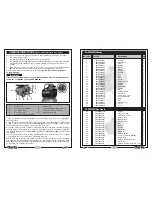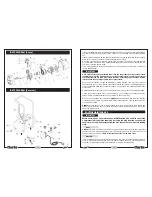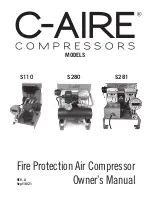
- 4 -
- 11 -
ELECTRICAL CONNECTIONS
Connect the mains lead to a standard, 230 Volt (50Hz) electrical supply through an approved
13 amp BS 1363 plug, or a suitably fused isolator switch.
WARNING! THIS APPLIANCE MUST BE EARTHED
IMPORTANT:
The wires in the mains lead are coloured in accordance with the
following code:
Green & Yellow
-
Earth
Blue
-
Neutral
Brown
-
Live
As the colours of the flexible lead of this appliance may not correspond with the coloured
markings identifying terminals in your plug proceed as follows:
Connect GREEN & YELLOW cord to terminal marked with a letter “E” or Earth
symbol “ ” or coloured GREEN or GREEN & YELLOW.
Connect BROWN cord to terminal marked with a letter “L” or coloured RED.
Connect BLUE cord to terminal marked with a letter “N” or coloured BLACK.
IMPORTANT
If this appliance is fitted with a plug which is moulded onto the electric cable (i.e. non-
rewireable) please note:
1.
The plug must be thrown away if it is cut from the electric cable. There is a
danger of electric shock if it is subsequently inserted into a socket outlet.
2.
Never use the plug without the fuse cover fitted.
3.
Should you wish to replace a detachable fuse carrier, ensure that the correct
replacement is used (as indicated by marking or colour code).
4.
Replacement fuse covers can be obtained from your local dealer or most
electrical stockists.
Fuse Rating
The fuse in the plug must be replaced with one of the same rating
(13 amps)
and this
replacement must be approved to BS1362.
We recommend that this machine is connected to the mains supply via a Residual Current
Device (RCD)
If in any doubt,
DO NOT
attempt any connections or repairs yourself. Consult a qualified
electrician, your Clarke dealer, or CLARKE International Service Dep’t on
020 8988 7400
or e-mail: Service@clarkeinternational.com
PROBLEM
CAUSE
CORRECTION
Paint does not atomise
Paint is too thick, air
Add thinners. Increase air press.
(comes out in blobs)
pressure is too low.
(not above 50 psi, unless
specified by paint manuf.
Paint dries before hitting
Paint is too thin. Air
Add more paint.
surface, leaving it dry
pressure is too high
Reduce air pressure
with a rough texture
Finish is pitted like
Air pressure too high
Reduce air pressure,
Orange peel
or spray too close to
increase distance between
work
gun and work.
PAINT SPRAYING HINTS
WARNING
NEVER attempt to spray unless you are wearing suitable, approved respiratory and
eye protection.
REMEMBER that some modern paints require specialist respiratory protection...always
consult the paint manufacturers instructions.
1. General Preparation
a. Ensure that the area in which you will be spraying is clean and dust free.
b. Connect spray gun to compressor via suitable flexible hose.
c. With no paint in spray gun, test system for air leaks.
d. Cover adjacent pieces of equipment to prevent overspray. Mask areas
of the article not to be sprayed.
e. Ensure surface to be painted is clean, dry and free from oil and dust.
Check paint manufacturer’s instructions for any special surface
preparation required.
REMEMBER - TIME SPENT PREPARING SAVES TIME SPENT FINISHING
2. Paint Preparation
a. Achieve the correct paint viscosity. This should be done according to
paint manufacturer’s instructions, and will vary according to type of paint.
b. Having mixed the paint thoroughly in a separate container, pour into the
spray gun paint container through a fine filter.
DO NOT
OVERFILL SPRAY GUN PAINT CONTAINER - three quarters full is maximum
c. It is usually best to experiment with a couple of practice spray coats on a
piece of material with the same type of surface as the article you wish to
spray, eg. metal for a car body panel, wood for a piece of furniture etc.
d. Some common problems:


























